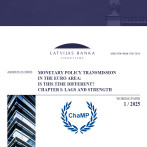A moderate rise in money supply resumes
The money supply underwent a moderate rise in February as the balance of deposits attracted by banks grew, including the return to banks of some of the increased amount cash currency circulating at the end of last year. Thus, following the seasonal drop in January, the total money supply approached the high level of December 2011, with deposits exceeding it already and demand for cash currency still below it. The loan balance continued to drop, with lending both to businesses and households down and the rate of lending drop almost matching the January indicator.
The loan balance in February shrank 0.6%, with loans in euro dropping and loans in lats rising. As a result of base effect, the overall annual drop rate of the banks' loan portfolio improved by 0.5 percentage points to -7.7%, and the balance of loans granted in lats by the end of February had grown by25.7% year-on-year.
The money indicator M3, which characterizes the amount of cash and non-cash currency in the economy grew 0.9% in February, with its annual growth rate at 1.5%. The balance of bank attracted deposits grew 1.7% in February, mostly on account of business deposits both in lats and foreign currencies. Household accruals in banks, on the other hand, increased by a mere 0.5%, and deposits in euro even decreased.
In the rise of money supply after the year-end turbulence, deposits are once again dominant, with the role of cash currency gradually diminishing, albeit its amount in circulation outside banks still exceeds last year's level substantially. In the coming months we can expect a minimal increase in household deposits that will be determined by the record high prices of energy resources, including those of heating and fuel, which will prevent additional accruals, and by the diminished role of the euro in household accruals possibly resulting from the controversy surrounding the fate of the euro area. A more rapid rise is possible in business deposits as they make accruals before the possible turbulence in the external markets. Banks' loan portfolio will continue to shrink gradually as the paid and written-off loans continue to exceed the amount of newly granted loans. Even though the domestic economy has yet to show any notable signs of slowing down after the successful development of last year, the weakening of external demand and high risks inherent in the external environment will act to dampen precisely the desire of the most stable and successful businesses to borrow.
Textual error
«… …»






